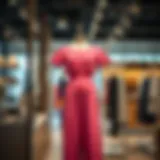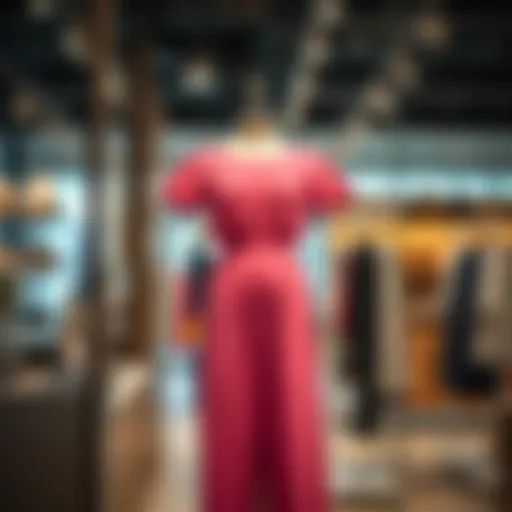Non-Skid Pads for Heels: Enhancing Style and Safety


Intro
In the ever-evolving world of fashion, non-skid pads for heels have quietly gained their spot in the limelight, often overlooked yet essential for both style and safety. As footwear trends fluctuate with the seasons, these pads serve as the unsung heroes, marrying elegance with practicality. This article embarks on a journey through the intricacies of non-skid pads, highlighting their material composition, advantages for wearers, and their broader impact on fashion and safety.
With the right non-skid pad, even the highest of heels can transform from treacherous to transcendent. They don’t just promise stability; they also encourage wearers to experiment with daring styles that otherwise might be scuttled by the fear of slips and tumbles. Thus, understanding how to select the right product becomes paramount for fashion enthusiasts and retail professionals alike.
Beyond this, considerations for foot health and sustainability are creeping into the mainstream conversation, making it crucial to evaluate innovations in non-skid designs as we move forward. Join us as we unpack all these elements, aiming for a comprehensive understanding of how these pads not only enhance comfort but also redefine what it means to step out in style.
Understanding Non-Skid Pads
When discussing the world of footwear, one element often brings both style and functionality into the limelight: non-skid pads for heels. Their importance cannot be overstated, especially for folks who prioritize both aesthetics and safety in their shoe choices. These little pads have a reputation for transforming slippery soles into stable platforms, making a world of difference whether you're strutting down the street or dancing the night away.
Definition and Purpose
Non-skid pads, often known as heel grips or traction pads, are designed to provide additional grip to the soles of high-heeled shoes. They adhere to the bottom of the shoe, creating more friction when walking. The core purpose of these pads is straightforward: to prevent slips and falls while enhancing the overall comfort of the wearers. For anyone who's navigated a glossy marble floor in a stunning pair of stilettos, the benefits of such pads are immediately evident—one misstep can lead to a catastrophic trip or worse.
However, these pads do more than just prevent unfortunate spills. They can also serve as a buffer, absorbing shock and reducing strain on the feet. With many options available in various materials, they can suit different heel types and cater to personalized preferences in terms of feel and look. Essentially, non-skid pads are a must-have in modern fashion—a blend of practicality and style that adds value to any heel collection.
Historical Context
The journey of non-skid pads is not just a tale of functionality; it reflects a broader evolution in the fashion industry’s approach to safety and comfort. In the earlier days, high heels were purely a luxury item, often sacrificing comfort at the altar of style. Women would wear heels regardless of the potential hazards—an unsteady heel on a cobbled street was just part of the package.
As time passed, more people, both in casual and formal settings, began to recognize the risks associated with high heels. This shift in awareness led to a demand for safer alternatives, ultimately sparking innovation in the production of non-skid pads. Companies started experimenting with different materials, exploring rubber, silicone, and specially designed adhesives to enhance stability and comfort. Today, these pads are celebrated not just for addressing safety concerns but for fulfilling a desire for chic yet functional footwear.
“Fashion is about something that comes from within you.” — Ralph Lauren
In summary, understanding non-skid pads means grasping their dual role—an accessory that marries form with function, offering comfort and stability without compromising style. For both fashion enthusiasts and retail professionals, knowing the perks and history surrounding these pads can inform better choices, whether in design or purchasing, and ultimately improve the overall shoe experience.
Material Composition of Non-Skid Pads
The material composition of non-skid pads holds significant importance in enhancing the overall functionality and performance of these accessories. Understanding the various materials used is crucial not only for ensuring comfort and safety but also for making informed choices when selecting pads. The right materials can elevate a simple fashion item into a solution that promotes health and stability while walking in high heels.
Types of Materials Used
When it comes to non-skid pads, the variety of materials available can be quite extensive, each offering its own set of advantages. Here are some of the most common types:
- Silicone: Flexible and cushiony, silicone pads provide excellent grip and absorb impact, making them a popular choice for many wearers. They are also soft enough to mold slightly to the foot, enhancing comfort during use.
- Rubber: Known for its durability, rubber pads generally offer exceptional traction. They’re often used in designs aimed at those who walk on slick surfaces, helping to prevent slips and falls.
- Foam: Lightweight and often more affordable, foam non-skid pads are made from various densities of foam material. Although they provide decent cushioning, the longevity can be a concern if they are not made from higher-quality foam.
- Textile: Some non-skid pads feature a textile upper, which can add a stylish flair while also providing a certain level of grip. These pads often tend to be more breathable but may not be as effective in wet conditions.
When selecting a material, it’s essential to assess what best suits not only the shoe type but also the wearer’s intended use. Will they be traversing a dimly lit dance floor or striding confidently into a busy office? Each scenario may call for different material considerations.
Durability and Longevity
Durability is a critical factor when evaluating non-skid pads. The lifespan of the pads often depends on material composition as well as the frequency of use. Key points to consider include:
- User Behavior: Regularly wearing high heels increases wear and tear on pads. Those frequently wearing them for extended periods may need to replace them more often than someone who only wears heels on special occasions.
- Material Quality: High-quality materials typically result in longer-lasting pads. For instance, silicone tends to outperform foam in terms of durability due to its inherent properties.
- Environmental Factors: External conditions such as humidity and temperature fluctuations can significantly affect longevity. For example, if pads are used primarily in wet weather, those made of rubber may eventually lose effectiveness compared to silicone options.
Understanding these aspects can help ensure that the pads chosen not only meet immediate needs but also maintain their functionality over time. Investing in durable materials can save money in the long run while ensuring safety and comfort with every step.
"Choosing the right material is like putting on armor. It protects not just your shoes but your entire experience with heels."
Benefits of Non-Skid Pads for Heels
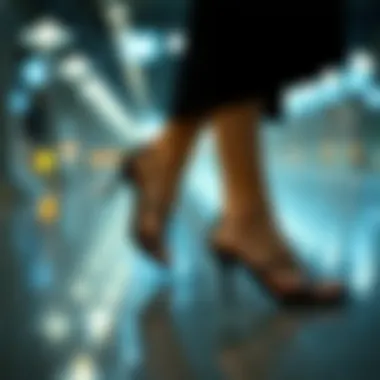

Non-skid pads for heels offer a multitude of advantages that cater not just to the aesthetic desires of fashion enthusiasts but also to the practical needs of wearers. From providing enhanced safety to increasing comfort, these little accessories pack a punch in both function and style. Understanding their benefits is essential, especially when one considers the potential discomfort and risks posed by high heels. Let's delve into several key aspects that highlight how these pads elevate the overall heel-wearing experience.
Enhanced Safety
Safety is paramount when it comes to wearing high heels. Whether strutting down city sidewalks or navigating slippery surfaces, non-skid pads provide increased traction that reduces the chances of slips and falls. High heels can feel like walking on stilts; one wrong step might lead to a mishap that can result in injury. By affixing non-skid pads to the soles, wearers gain a firmer grip that translates into confidence with every step.
- Improved Stability: Non-skid pads help stabilize heels by ensuring they grip the ground better, especially on uneven terrain.
- Versatile Use: From cobblestones to shiny marble hallways, these pads work well across different surfaces, ensuring you stay grounded.
- Peace of Mind: With added protection against slips, wearers can enjoy their time out, free from the nagging worry about a potential fall.
"Non-skid pads turn a precarious situation into a walk in the park!"
Increased Comfort
Comfort is an essential factor to consider when selecting footwear, particularly if one is accustomed to wearing heels for extended periods. Non-skid pads serve as an unseen hero, providing cushioning and support where it’s needed most. The right pair of pads can reduce foot fatigue, which is especially beneficial for those who spend their days on their feet.
- Shock Absorption: Many non-skid pads feature memory foam or gel, absorbing shock and reducing the impact on joints and muscles.
- Customized Fit: Pads can often be trimmed to fit specific heels, allowing for a snug fit that helps distribute body weight more evenly, thus minimizing discomfort.
- Enhanced Arch Support: Some designs provide additional arch support, crucial for maintaining a healthy foot posture during long hours of wear.
Fashion Considerations
In the world of fashion, aesthetics gleam just as brightly as practicality. Non-skid pads don’t merely protect the wearer; they also preserve the integrity of high heels. Scuffed or worn-out shoe soles can mar even the most elegant footwear. Having non-skid pads on hand offers a protective layer that enhances both the life of the shoe and its classy appeal.
- Maintain Style: By preventing scuffing, these pads help heels remain in pristine condition.
- Subtle Appearance: Many pads are designed to be discreet; they blend seamlessly with the shoe’s silhouette without detracting from style.
- Color Coordination: Some brands offer pads in various hues, allowing fashion lovers to match pads with their footwear for a cohesive look.
In summary, incorporating non-skid pads into your heel-wearing routine stands as a wise choice for anyone looking to merge safety, comfort, and style. Choosing the right pads aligns well with the intrinsic needs of the modern wearer, ensuring each outing is not just a statement of style but also a practical step towards a better heel experience.
Selecting the Right Non-Skid Pads
When it comes to non-skid pads for high heels, the choices can be as dizzying as a stroll down a busy fashion district. Selecting the right non-skid pads is crucial, as this decision impacts not only your safety but also your overall comfort and style. The right pads can mean the difference between strutting confidently down the street and teetering like a newborn giraffe.
Understanding what to look for in these essential accessories helps ensure you get the best out of your heels without falling flat. Here, we’ll discuss key elements such as size, fit, and compatibility with various heel types, so you can make an informed decision that meets both your fashion and functional needs.
Size and Fit
Finding the perfect size and fit for your non-skid pads is akin to finding the right pair of shoes—it requires attention to detail and perhaps a bit of trial and error. Non-skid pads come in a range of sizes, designed to cater to different shoe dimensions. If the pad is too small, it may not provide the necessary coverage, leaving you vulnerable to slips. Conversely, a pad that’s too large could create uncomfortable bulges or interfere with the shoe's aesthetic appeal.
To get it right:
- Measure your shoe size: A straightforward step, but often overlooked. Measure your foot length and width to find out what size pad will suit you best.
- Check for adjustable options: Some pads offer adjustable sizes, which is a nifty feature if you have a varied collection of heels.
- Consider the shoe's structure: Pumps might require different sizing than stilettos or block heels. Pay attention to the contour of your shoes when selecting pads.
The right fit not only ensures comfort but also optimizes the pad's effectiveness, keeping you safe and stylish.
Compatibility with Various Heel Types
High heels come in countless shapes and styles—each with its own idiosyncrasies. Understanding how non-skid pads align with your specific heel type is essential to ensure a snug fit and a secure grip. Here are some major heel categories and considerations:
- Stilettos: These often require a thinner pad that fits snugly beneath the point of contact. A slim design will provide the added grip without compromising the elegant silhouette.
- Block heels: A wider base calls for pads that cover more surface area. Go for thicker, more durable options to ensure stability and comfort while walking.
- Wedge heels: While these heels generally provide more stability, non-skid pads can enhance safety, particularly on slippery surfaces. Choose pads that follow the wedge's contour for optimal performance.
In short, the correct non-skid pad can amplify the strengths of your heel type while mitigating weaknesses. It is vital to experiment with different options until you find the one that feels like a glove.
"Choosing the right non-skid pads is like choosing a partner; compatibility is key for a harmonious relationship."
Ultimately, taking the time to select the appropriate non-skid pads maximizes your heels’ potential—combining functionality with aesthetic appeal. The right choice will help keep you safe and stylish, leaving you to navigate your day with confidence.
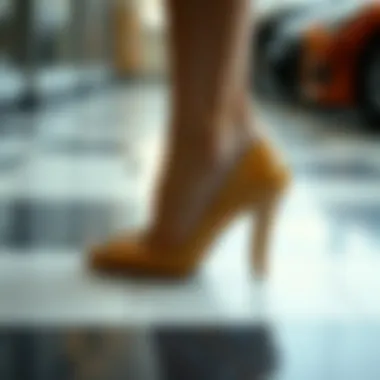

Types of Non-Skid Pads Available
Understanding the different types of non-skid pads is crucial for anyone looking to enhance both safety and comfort while wearing heels. Choosing the right type can make or break your experience with footwear. Below, we will explore two primary categories: adhesive vs. non-adhesive options and customizable pads. Each of these categories comes with its own advantages, so it’s important to know what fits your needs the best.
Adhesive vs. Non-Adhesive Options
When diving into the realm of non-skid pads, the distinction between adhesive and non-adhesive options stands out, much like the difference between a good cup of coffee and a mediocre one. Adhesive pads are designed to stick right onto the bottom of your heels, ensuring a solid grip with the surface beneath you. They’re often made from materials that provide excellent traction, allowing you to strut confidently, whether you’re walking on city streets or fancy restaurant floors. However, there could be some drawbacks, such as wear and tear over time or residue left behind when they're removed.
On the flip side, non-adhesive pads offer a more versatile approach. These pads can be repositioned or removed without the fuss of sticky residue. They typically fit snugly inside the heel, providing a barrier between your foot and the shoe. This can be great for shortening the lifespan of your beloved pair of heels, as it minimizes friction and pressure. Both options come with their own set of advantages, and the right choice depends on the specific needs and preferences of the user.
Customizable Pads
The trend toward personalization permeates all aspects of fashion, and non-skid pads are no exception. Customizable pads allow wearers to tailor their experience. This not only enhances comfort but also ensures that the fit is just right. Various thicknesses and shapes can be chosen based on individual foot anatomy, heel height, and shoe style.
"A shoe is only as good as the feet inside it."
This quote rings particularly true when it comes to customizable non-skid pads. They provide an opportunity to adapt to your unique body. For people dealing with foot conditions, like bunions or Plantar fasciitis, the ability to modify pads can make all the difference. These pads not only improve comfort but can also enhance posture and balance, making them a worthy investment for anyone who wears high heels regularly.
By understanding these two types of non-skid pads, consumers can make informed choices tailored to their lifestyle and footwear preferences, thus elevating their wearing experience.
Health Implications of Wearing Heels Without Pads
High fashion often comes with trade-offs. While heels can elevate one’s look, they can also wreak havoc on foot health. For those who frequently wear heels, understanding the health implications that arise from not using non-skid pads becomes imperative. Wearing heels without the added support of pads can lead to discomfort and various foot conditions that may linger long after the shoes are off. The following sections delve into the foot conditions associated with high heels and what preventative measures can be taken to mitigate these risks.
Foot Conditions Associated with High Heels
High heels, while making a strong fashion statement, often force the foot into unnatural positions. Some common conditions include:
- Plantar Fasciitis: This condition originates from increased pressure on the arch of the foot, leading to inflammation of the tissue connecting the heel bone to the toes. Wearing heels often exacerbates this issue.
- Bunions: A bony bump at the base of the big toe can be aggravated by the narrow toe box of high heels. The alignment issues caused by prolonged heel wear often worsen this condition.
- Morton’s Neuroma: This entails pain or swelling between the toes, typically caused by repeated pressure on the ball of the foot—an area often under strain when heels are worn without pad support.
- Ankle Sprains: Heels can alter balance, leading to higher chances of twists and sprains.
- Calluses and Corns: These form as protective responses to excessive friction and pressure. Often, high heels increase the risk of their formation.
"Sore feet from high heels can be a sign of something more serious. Taking care of your feet is not just aesthetic; it’s essential for your overall health."
These conditions not only lead to discomfort but may escalate to more serious complications if ignored. Therefore, integrating non-skid pads into the heels is not merely about enhancing traction but also about maintaining foot health.
Preventative Measures
Given the potential hazards associated with high heels, proactive measures are vital for anyone who cherishes style but craves comfort. Below are several strategies one could consider:
- Select Heels with Adequate Support: Opt for shoes that feature built-in arch support or cushioned insoles, it may help distribute weight more evenly.
- Utilize Non-Skid Pads: Using pads can alleviate some pressure while improving grip and stability. These pads provide an extra layer of cushioning that prevents feet from sliding forward, reducing strain on the toes.
- Limit Wear Time: If possible, restrict the duration that heels are worn. Switching to more comfortable footwear during prolonged standing can significantly lessen foot strain.
- Foot Exercises: Engage in exercises designed to strengthen foot muscles. Stretching and strengthening can go a long way in alleviating discomfort.
- Professional Fitting: Ensure shoes fit properly. Ill-fitting shoes can lead to a multitude of problems, from blisters to more severe structural issues.
- Consult a Podiatrist: If foot pain persists, it may be wise to seek professional help to address any underlying issues before they escalate.
By taking these preventative measures, one can minimize the negative impact of heels on their foot health. It’s essential to strike the right balance between style and well-being, ensuring that every step taken is confident and comfortable.
Environmental Considerations
When discussing non-skid pads for heels, it's crucial to consider their environmental impact. As the fashion industry continues to evolve, sustainability has become a pressing concern. Non-skid pads, while small, contribute to environmental changes through their material choices and manufacturing processes.
Sustainability in Material Selection
Sustainability in material selection plays a pivotal role in how non-skid pads can align with greener practices. Traditional materials like rubber and plastic have numerous downsides, such as lengthy decomposition periods and a heavy carbon footprint from production.
Modern advancements suggest the use of eco-friendly alternatives. Materials such as biodegradable rubber or recycled plastics are gaining traction. Choosing these options can significantly reduce waste. For instance, some brands have embraced plant-based materials that not only provide grip but also decompose naturally over time.
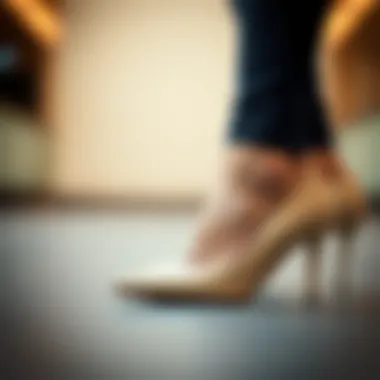

Benefits of sustainable choices include:
- Lower environmental footprint: Using renewable resources mitigates harm to the planet.
- Consumer awareness: Shoppers are becoming more discerning, favoring brands that prioritize sustainability.
- Brand reputation: Companies adopting eco-friendly practices can enhance their public image, leading to improved customer loyalty.
Impact on Fashion Industry Practices
The adoption of sustainable non-skid pads resonates throughout the fashion industry, altering production practices and consumer habits. Brands are increasingly motivated to explore sustainability, not just to meet demand but to stay relevant. The ripple effects of these changes can be substantial.
Here are some ways the industry is responding:
- Innovative supply chains: Companies are reevaluating their supply chains to ensure ethical sourcing of materials.
- Regulatory compliance: With regulations becoming stricter regarding environmental practices, brands must adapt.
- Transparency: More consumers are seeking information about how products are made. Brands that share this information often gain a competitive edge.
In summary, environmental considerations surrounding non-skid pads for heels are integral to both their design and the broader implications within the fashion industry. As material selection shifts towards sustainability, we see not only an enhancement in product longevity, but a positive impact on the market as a whole.
"The intersections of sustainability and fashion are not just a trend; they are becoming the bedrock of how successful brands will operate in the future."
Understanding these dynamics can empower both consumers and producers alike to make informed decisions about their products and purchases. In looking forward, the shift towards sustainability in non-skid pads may very well pave the way for a more eco-conscious fashion landscape.
Future Innovations in Non-Skid Designs
The realm of non-skid pads for heels is on the verge of transformative change, driven by a desire for both enhanced functionality and aesthetic appeal. As fashion continues to evolve, so too must the accessories that accompany it. Non-skid pads are, quite literally, underfoot — a bridge between style and safety. With increasing awareness surrounding both the environmental impact and personal health implications of footwear choices, future innovations in non-skid designs hold immense promise.
Technological Advancements
Technological progress has a knack for improving everyday products, and non-skid pads are no exception. Here are some noteworthy advancements to keep an eye on:
- 3D Printing: Customization is set for a major upgrade through 3D printing. With this technology, non-skid pads can be tailored to individual foot shapes, offering a snug fit and improved grip. Essentially, the pads could mold to the unique curvature of a wearer’s heel, easing discomfort while ensuring stability.
- Anti-Microbial Coatings: Imagine a pad that not only keeps you from slipping but also fights off bacteria. Innovations in material technology are allowing for coatings that can withstand sweat and moisture, keeping pads fresher for longer periods. This is especially pertinent for those who wear heels for extended periods.
- Smart Sensors: With the rise of wearable technology, the future may incorporate smart sensors into non-skid pads, alerting wearers about slipping risks or improper foot placement. Being able to receive real-time data on your posture can guide the user toward safer walking habits.
These advancements serve to not only elevate the functionality of non-skid pads but also align them with the modern consumer's expectations for dual-purpose products — stylish yet sensible.
Potential for Smart Materials
The exploration into smart materials could redefine how we think about non-skid pads. These materials are reactive and adaptable, allowing pads to alter their properties based on environmental conditions. For instance:
- Pressure-sensing Materials: Envision pads that can adjust their grip based on the pressure applied by the wearer’s foot. This could lead to better traction on slick surfaces or enhanced cushioning during high-impact movements.
- Temperature Regulation: Materials that adapt to temperature changes could enhance comfort. A warmer pad during winter could ease discomfort in cooler conditions, while cooler pads during summer would maintain freshness.
- Recyclable Components: As sustainability becomes unavoidable in fashion, smart materials that can be easily recycled or upcycled should be a priority. This innovation not only supports environmental goals but also mirrors a consumer base increasingly composed of eco-conscious individuals.
The End
In the ever-evolving landscape of footwear, the role of non-skid pads stands out as a crucial element for both safety and style. These seemingly simple accessories have profound implications that extend beyond just preventing slips. They encapsulate what it means to balance aesthetics with functionality, serving as a silent partner to fashionable yet often precarious heels.
Summary of Key Insights
Reflecting on the insights shared throughout this article, several key points emerge:
- Safety First: Non-skid pads play a vital role in enhancing the safety of high-heeled shoes. They significantly reduce the risk of slips and falls, offering wearers a sense of confidence with each step. The inclusion of such pads transforms how one approaches high-heeled footwear, allowing for greater wearability in diverse environments.
- Comfort Matters: Many fashion enthusiasts often overlook the comfort aspect when selecting heels. However, non-skid pads can contribute to a more cushioned experience, thus reducing fatigue over time. This is especially important for those who spend long hours on their feet.
- Variety and Compatibility: With a range of options available—from adhesive to non-adhesive pads—finding the right fit for different heel types becomes easier. Retail professionals can capitalize on this variety to cater to a broader audience, providing tailored solutions to meet individual needs.
- Health Considerations: Wearing heels, particularly without proper support, can lead to various foot conditions. Non-skid pads not only mitigate risks but also encourage wearers to embrace their preferred styles while taking care of their feet. This synergy of health and style should be a focal point for dialogue between consumers and retailers alike.
This holistic understanding of non-skid pads emphasizes the need for awareness among footwear consumers. The pads not only serve a structural purpose; they also embody an essential part of the wearer’s overall experience.
Final Thoughts on Non-Skid Pads
As we wrap up this exploration, it’s evident that non-skid pads are more than just practical accessories. They are a testament to how functional design can influence personal style and safety in the realm of fashion. In today’s dynamic market, where trends continuously shift, incorporating these pads into footwear not only enhances usability but also aligns with growing consumer demands for comfort and safety without sacrificing aesthetics.
Moving forward, the focus should turn towards broader adoption among manufacturers and retailers alike to educate and equip consumers about these innovations. Ultimately, embracing non-skid pads may very well redefine how high heels are perceived—shifting away from impractical beauty to functional elegance.
"In fashion, as in life, balance is key. Non-skid pads are the unsung heroes that harmonize comfort with chic."
For those keen on exploring further adaptations in heel designs and understanding consumer preferences, resources such as Wikipedia or Britannica can provide in-depth insights. Meanwhile, discussions on platforms like Reddit can yield real-world testimonials from both wearers and fashion professionals.


